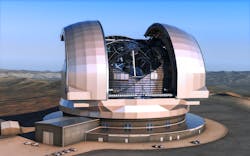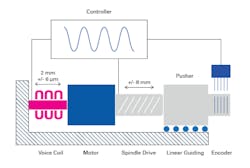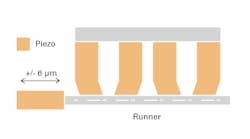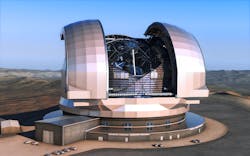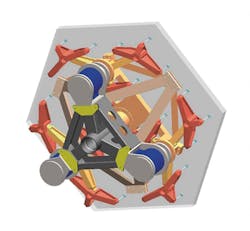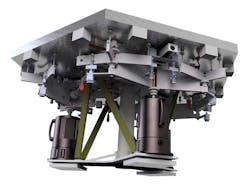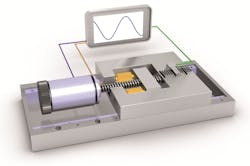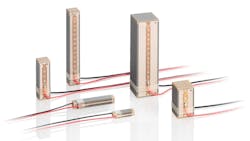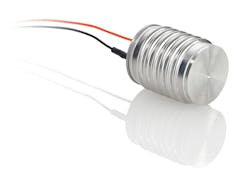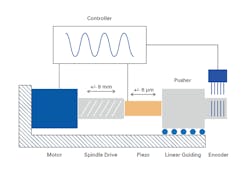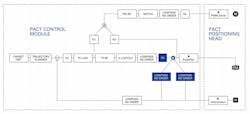Smart, Hybrid Actuators Get Practical With Precision
When faced with challenging alignment applications, designers often have to live with an unsatisfactory compromise between accuracy, force, and dynamics. Hybrid drives combine two different drive concepts into a high-performance and precision positioning system—taking advantage of both drives. These types of solutions are always in demand when one drive alone is not capable of meeting all of the requirements of an application.
An example of this can be shown by nanometer-precision positioning of heavy loads over long travel ranges. Nanopositioning systems that combine piezo drives with classical drive screws offer a practical solution while enabling the possibility of more than one drive concept. Application areas include precision movement of telescopes, measuring technology, surface inspection, semiconductor manufacturing, microscopy, and laser technology.
Hybrid Concept with Electric Motor and Voice Coil
Various concepts have already been developed and implemented for hybrid positioning systems. One solution, for example, is a combination of linear motors and voice coil actuators (Figure 1).
Linear motors offer long travel ranges with high positioning accuracy and repeatability but do have the disadvantage of high friction in the linear guides used for taking up the load. Nevertheless, voice coil actuators do provide precision positioning as well as good force control and smooth motion. However, their travel range is limited to 100 millimeters and they can only hold loads at rest when they are powered on.
Hybrid Concept with Piezo Walking Drive and Piezo Actuator
Physik Instrumente (PI) has already successfully developed and established a further hybrid drive concept for other applications, such as those for inspecting semiconductors.
A PiezoWalk drive that offers long travel ranges with high stiffness is combined with a PICMA actuator for high dynamics applications (Figure 2). The advantage to this concept—depending on the design of the PiezoWalk drive—is the possibility of realizing high holding forces. In this case, the high dynamics of the PICMA drive are important for the fast focusing of the object being scanned.
Hybrid Concept with Electric Motor and Piezo Actuator
PI is working on a project together with engineers and astronomers from the European Southern Observatory (ESO) which will result in the world's largest terrestrial telescope on the 3,000-meter-high Cerro Amazones in the Atacama Desert in Chile (Figure 3).
The telescope's revolutionary design consists of a main mirror (M1) with a diameter of 39 meters, which is divided into 798 independent mirror segments. Each mirror segment has a diameter of 1.4 meters and is positioned by three independent hybrid drives with a nominal travel range of +/- 5 millimeters (Figure 4).
Considerable masses must be moved for this–each mirror segment including its support weighs approximately 551 pounds. Due to the different alignments of the telescope, a total of 2,394 actuators need to be able to move and hold loads with push/pull forces between 463 and 1050 newtons (Figure 5).
One of the most important tasks of the telescope will be to supply the sharpest possible images of the universe, which researchers can use to search for Exoplanets, i.e., planets that exist beyond the solar system. Therefore, the greatest technical challenge will be to move the mirror segments over the entire range with a maximum position deviation of 2 nanometers.
In order to achieve this high path accuracy, PI developed a hybrid concept where a motor drive screw, that is suitable for heavy loads and long travel ranges, is combined with a piezo actuator (Figure 6). A serial combination of both very different drives results in a powerful and high-precision positioning system.
Piezo Actuators Position with Subnanometer Accuracy
Precision motion that results when an electrical voltage is applied to a piezoelectric material is of particular importance for nanopositioning. The electrical power is converted into mechanical energy directly inside the crystalline solid-state, which means that there are no rotating or frictional parts.
The piezo actuators not only work with high precision but are also maintenance and wear-free. They can move large loads with weights of up to several tons. Electrically, they act as capacitive loads and need virtually no power in static operation. The behavior in the power circuit is very much like an electrical capacitor. Similar to capacitors, they do not generate any heat in a static condition.
The lifetime of piezo actuators is also convincing: In the case of PICMA multilayer actuators (Figure 7), the active layers consist of thin ceramic films and are surrounded by an all-ceramic insulating layer that protects the actuators against air humidity and failure from leakage current. The monolithic piezoceramic block of such an actuator is very reliable even under extreme ambient conditions and high-temperature differences.
The piezo actuators used in the hybrid drive for the telescope segments are also encapsulated in sealed metal bellows filled with nitrogen (Figure 8) in order to reach the 30-years lifetime necessary in the adverse ambient conditions in the Atacama Desert.
A High-Resolution Sensor for Both Drive Systems
A further feature of the hybrid drives is the common high-resolution sensor, which helps to control both drives simultaneously and continuously. This is the only way to implement the high resolution of the piezo actuators over the entire travel range.
The high-resolution sensor is an incremental optical encoder that is placed near the drive axis (Figure 9). It operates at a resolution of 0.1 nanometers and is also not sensitive to the changing environmental conditions prevailing at the telescope's location in the desert.
The motor drive screw is suitable for heavy loads and long travel ranges starting at a few millimeters and going up to one meter. The piezo actuator provides a nominal displacement of approximately 0.1 to 0.15% of the actuator length, but nevertheless, achieves a positioning accuracy in the subnanometer range with one high-resolution sensor, and can therefore compensate for the inaccuracies of the motor drive screw.
The drive screw is driven by a brushless, high-torque motor via a high-ratio reduction gearhead.
The gearhead ensures zero-play operation and guarantees a constant transmission ratio. The motor can, therefore, be very small even though large masses have to be moved. The high transmission also supports the self-locking of the motor when at rest.
A dedicated controller controls both drives simultaneously and also controls the high-resolution position measuring system. The servo-algorithms consider the motor and the piezo system as a single drive unit and compare the actual motion with a calculated trajectory.
The control principle of the hybrid drive is easy to understand (Figure 10). The motor voltage is derived from the control voltage of the piezo. The greater this voltage, the faster the motor runs. When the piezo expands, the motor drives the drive screw in the same direction. In this way, the rough positioning of the drive screw is supplemented by the fine positioning of the piezo. At the same time, the drive screw always moves the piezo near to its zero position automatically. This gives it the best chance of correcting the position in both directions. In this way, relatively long travel ranges can be combined with an extremely high positioning accuracy.
The characteristics of these types of hybrid drives are not only useful for telescopes, but are always a practical solution when a position needs to be detected with high precision and moved repeatedly over long travel ranges, or when a target position needs to be reached with nanometer precision. Other typical application areas include measuring technology or surface inspection, semiconductor manufacturing, microscopy, and laser technology.
